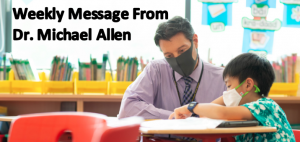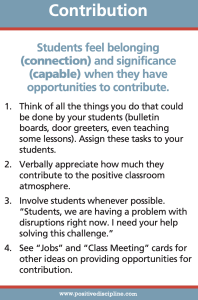Each week in the elementary school different tools and strategies to support students and guide their behavior choices are shared with the faculty and instructional assistants. This week the tool of “Contribution” was the focus as it’s one of the most important tools to develop intrinsically motivated students.
It’s important that students learn the art of contributing, a skill that will serve them throughout their lives. According to Adlerian psychology, the primary need of all people is a sense of belonging, and Gemeinschaftsgefühl is a measure of mental health. Gemeinschaftsgefühl essentially means “social consciousness and a desire and willingness to contribute.” Thus, belonging and contribution are equally important. Parents and teachers typically do a great job of helping their children feel a sense of belonging. However, the scales are out of balance when children are not also taught the importance of contribution. When contribution is missing, children develop a sense of entitlement.
Research shows that children seem to be born with a desire to contribute. Warneken and Tomasella found that children have a natural instinct to help others starting at a very early age. In one study, eighteen-month-olds and their mothers were brought into a room where they watched the experimenter drop clothespins. The toddler would watch for a few seconds before picking up the clothespin and handing it to the experimenter. In another scenario the experimenter tries to put books in a cabinet with the doors closed. The toddler watches him bump into the cabinet several times before he walks over to the cabinet and opens it for the experimenter. See video of experiment here: https://www.youtube.com/watch?v=kfGAen6QiUE
The more one wants to contribute (in his or her family, classroom, and community, and to the planet), the greater his or her overall mental health. Contributing promotes a sense of belonging and capability. We shouldn’t rob children of these gifts by doing too much for them. Anytime adults involve students in problem-solving and focusing on solutions, they learn a little more about how to contribute in a meaningful way. Students can contribute by assisting in the creation of routine charts, and wheels of choice, and positive time out spaces both at home and school.
Interested in learning more about how you can use similar tools at home? Check out Positive Discipline Parenting Tools: The 49 Most Effective Methods to Stop Power Struggles, Build Communication, and Raise Empowered, Capable Kids


